Weaubleau Congregational Christian Church
Note: Most of the items on this page
were copied from records found in the church in June 2005. Services continue to
be held in the church each Sunday.
1867 - 1960
WEAUBLEAU CONGREGATIONAL CHRISTIAN CHURCH
by Eugene Harryman,
Weaubleau, Mo.
In 1867, just after the Civil War, John Whitaker,
a young and enthusiastic pastor of a small Christian group, proposed the
building of a two story brick house to be used by the church for religious and
educational purposes. After much delay and sacrifice, a house was built; it
being 26 x 40 feet and two stories high, the first story being used for a chapel
and the second for an academy.
When the walls were nearly finished, the second story was blown down
in a wind storm, causing quite a hitch in the re-building of the school. The
corner stone was finally laid in July, 1869 and by October, 1871 a school was
started by the same pastor with six students. Such was the beginning of the old
Christian Institute and College at Weaubleau, Missouri.
For several years, the old Christian Institute, sometimes called to
"Old Brick," struggled for existence. Yet for twenty years the school honored
God and benefited man. More and more students found their way to the halls of
this great school, and after twenty years, a new commodious ten room structure
was finished and ready for occupancy by the fall term of 1893. It was just four
hundred yards northwest of the Old Brick and away from the business center.
Before the college was finished, the town began to grow and expand,
but only gradually until the Kansas City, Osceola, and Southern Railroad, later
called "Frisco," came in August, 1898. This put new life and brought new people
into the town. The "Iron Horse" with its magic speed came and went with its
cargoes of mail, passengers and merchandise twice daily. Thirty years had passed
since the doors of the school were thrown open to the youth of the country.
Another was to supercede the one which founded the school, yet the school
survived and prospered.
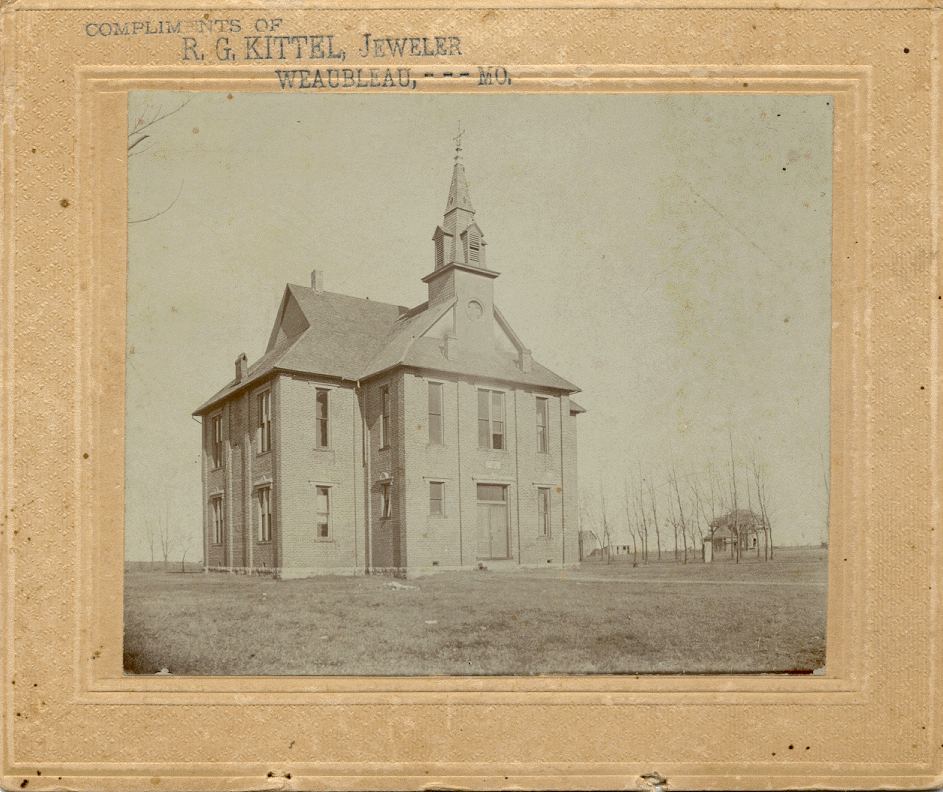 Almost two thousand students had received instruction here. Twenty
three classes with an aggregate of near eighty young men and women graduated
from this school. Weaubleau College had furnished superintendents or principals
for many grade and high schools, besides college and academy instructors, not
only throughout Missouri, but Oklahoma Territory, Arkansas, Nebraska, and Iowa.
Almost two thousand students had received instruction here. Twenty
three classes with an aggregate of near eighty young men and women graduated
from this school. Weaubleau College had furnished superintendents or principals
for many grade and high schools, besides college and academy instructors, not
only throughout Missouri, but Oklahoma Territory, Arkansas, Nebraska, and Iowa.
The various professions and business college had among their leading
representatives, students from the Weaubleau Christian College. John Whitaker,
the founder, being president of the Board of Trustees twenty five of the first
thirty years of the school's progress.
The Weaubleau Christian Institute, once known as the "Old Brick,"
was located in the southwest part of Hickory County on a beautiful and wild
prairie in a well-watered locality. When the house was built, there was but once
other near it. The school was begun when but one dwelling was nearer than half a
mile.
Since then, a school village grew up around the Brick and was called
Weaubleau, but was known as Haren at one time, and was located one half mile
west of Weaubleau. Weaubleau was an exceptional and thriving school village of
three hundred progressive people, with no "dram" shops or other dens of vice,
such as were often found in other towns and cities.
There was no railroad through Weaubleau, but the Kansas City,
Clinton, and Springfield had a station at Collins about five miles west, and was
connected by a "hook line" which met all trains twice daily. The Kansas City,
Osceola, and Southern Railroad was expected to come through Weaubleau at an
early date.
When the Weaubleau Christian College was in its thirtieth year,
1902-1903, the active members of the Board of Trustees were: Wm. R. Davies,
President; J. P. Ware, Secretary; T. J. Tucker, W. E. Crouch, T. Durnell, I.
Wiggins, John Monroe, John Whitaker, and S. W. Whitaker.
Some of the faculty included John Whitaker, professor of mental
philosophy; W. D. Webber, professor of Latin and Greek; Mrs. Lula Wilson
Whitaker, professor of mathematics; S. W. Whitaker, professor of education and
pedagogy; Martin. C. Schricker, instructor in music and voice culture; and J. B.
(Book) Orr, instructor in vocal music.
The college campus consisted of about three acres, all shaded by
young maples and catalpa trees, the street being used for an athletic field.
There were many valuable books and references, as well as several hundred
popular works in the library, to which the students had access at no extra cost.
There was also a laboratory and museum which contained useful apparatus and
chemicals for experimental purposes, as well as a fine collection of minerals.
Lectures and entertainments were held at intervals through the
school year with Literary and Social activities at the end of each term. The
three major degrees were Bachelor of Science, Bachelor of Accounts, and Master's
Degree.
The expenses in those wonderful college days were quite interesting
too, for instance—board, room, fuel, and light, per week was $2.00. Tuition 10
to 12 weeks was $7.00-$8.00-$9.00, spring, fall, and winter months. Lessons on
piano, organ, violin or other instruments were 50¢, 10 vocal lessons for $1.00.
By doing their own cooking, students could reduce their expenses to $1.00 a
week.
Even after the new college was completed, the old Brick's usefulness
was not ended, for the Literary and Endeavor Societies were held there, as well
as church and Sunday School and other organizations.
THE CHURCH TODAY
And so, after serving the
elements of time, the "Old Brick" was razed and replaced by a modern edifice in
1910. It was called the Christian (Brick) church. Many of the original bricks
were used in this structure.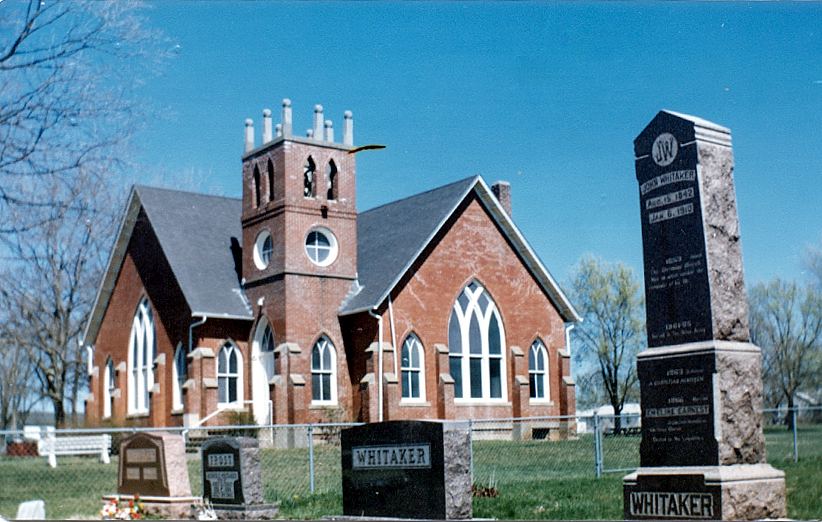
Today and four generations after the "Old Brick" was organized by
the young enthusiast, John Whitaker, the church still stands, and is known as
the Christian Congregational Church. It merged with the Congregationalists about
1936. It, too, has weathered the years, surviving two draughts, one in
1934-1936, and in recent years, 1952-1954. It, like many buildings, settled and
cracked, but was put in good order by members of the same religious faith as
that of the same people who organized the church.
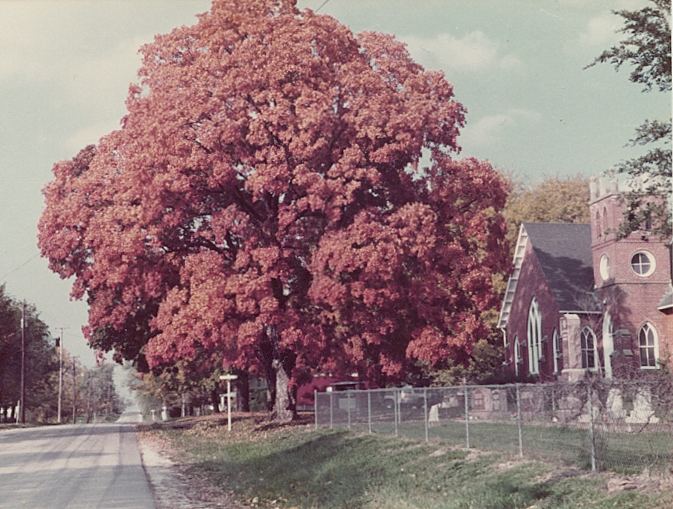 In those early years of the Christian Institute, the students set
out beautiful shade trees, and a few of them are still standing today. They have
taken much punishment from ice storms and draughts in recent years, but they
still have much color in the fall of the year. [Photo at
left taken in 1983; tree has since been removed due to disease.]
In those early years of the Christian Institute, the students set
out beautiful shade trees, and a few of them are still standing today. They have
taken much punishment from ice storms and draughts in recent years, but they
still have much color in the fall of the year. [Photo at
left taken in 1983; tree has since been removed due to disease.]
Now that we have learned something of the "Old Brick", let us see
what has become of the Weaubleau Christian College. First, we want to remember
that Prof. John Whitaker was still head of it in 1902-1903, as I have mentioned
earlier, and continued until his retirement, or when his son, C. S. Whitaker,
took over in the autumn of 1906.
Dr. Fredrick Cooper, D. D. minister, who graduated from Kansas
Christian College in the spring of 1906, (now deceased) was under C. S. Whitaker
for about a year. In August, 1907 he was called to take charge of the college,
as Mr. Whitaker was to supply Union Christian College at Merom, Indiana. Dr.
Cooper continued with the church and college work until August 1913, when he was
called to Palmer College at Albany, Missouri as dean and College pastor. Mr.
Whitaker took over and held school at least one year, 1913-1914. After standing
idle for a time, or until about 1917-1918, the college building was then used
for a four year high school, Mr. Whitaker being one of the first teachers. It
was used for this purpose until the fall of 1932, when it was destroyed by fire.
The school term was finished in the various churches about town.
It was about this time that the college grounds were turned over to
the Weaubleau School District and a new and modern one story school was build
and ready for the fall and winter term of 1932-1933. After many years of
service, this building also went up in flames December 5, 1957 and the students
again had to finish the school term in the various churches. Just a year to the
day, December 5, 1958, school was again restored in another new, modern, one
story structure, taking care of both high and grade school children.
After the death of Mrs. Annette Whitaker, widow of the late O. B.
Whitaker, las of May, 1954 members of the Congregational Christian Church had
permission to take the books that once lined the shelves of the old Institute
and College. They accepted the challenge and much of the library was moved to
its new location. It will be preserved and kept in memory of the "Old Brick"
which was first organized in 1867.
In looking through the books of the old library, a member found a
sheet of onion paper neatly folded. On it were several verses written by the
late S. W. Whitaker who was once a student and teacher in the old Institute and
College. With the consent of Mrs. S. W. Whitaker, the writer dedicates these
verses in memory of the Weaubleau Christian Institute and College.
[Link
to Membership Register, ca. 1937-1996]
"OUR GIRLS"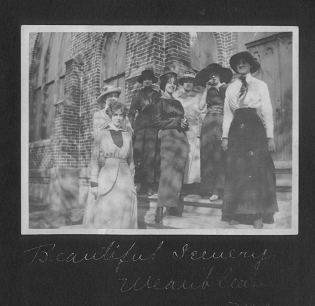
The merriest o'er
whom our flag unfurls,
Is surely a ground of happy girls.
You
may search the land, parlor to Flagon;
But find true happiness in a lumber wagon.
If
filled with girls to its utmost might,
Who are driving out on a star light night,
To
church or lecture, speech or something - -
To anything at all, or nothing.
There is music in their merry laugh - -
The finest band it beats by half.
The
snatches of songs in wild discords,
With diverse tunes and different words - -
And
when by chance some tone prevails,
Some tune rings out o'er hills and dales,
As
fifteen voices, clear and strong,
Ring out through the woods as they drive along.
It
would touch the heart of a listener, though
He be frosty and cold as the winter snow.
Of
happy girls there is many a band;
But ours are the truest in all the land.
With cultured mind and woman heart --
Each in life's battles will play a part.
Though they will go out to their own little worlds
We will always be proud of our '98 girls.
Signed: S. W. Whitaker, Nov. 5,
1898
ALUMNI
1877: M. F. Butler, Mrs. T. L.
Cooley Redford, W. J. Hawkins.
1878: A. L. Lacy, J. H.
Logan, J. E. Barber, J. L. Young
1885: J. S. Snidow
1886: G. A. Whelock, Mrs.
Minnie Whitaker, E. L. Butler
1887: G. W. Lemon, A. L. Smith, T.
B. Marquis, R. W. Tucker, J. O. Birch, J. W. Russell, Laura O. Whitaker
1888: J. A. Woodford, O. B.
Whitaker, W. W. Tharp
1889: Charles W. Pharis
1890: B. F. Tucker
1891: John D. Riley
1892: W. L. Helton, W. A.
McMahan, W. A. Whitaker
1893: J. E. Bradley, J. V.
Knight, W. N. Riley, J. M. Murphy, T. S. Roman, Mrs. Delia Whitaker, Mrs. Mattie
Bishop, _____ Butler
1894: J. H. Holt, Cyrus
Paxton, G. W. Davies, S. W. Whitaker
1895: H. H. Rogers, W. C.
Scott, Theo. Pruet, Elmer Tucker, G. E. Holt, J. S. Whitaker, Miss Ella Holt,
Miss Cora Arnold, _____ Mills
1896: J. T. McCracken,
Myrtle Lindsey-Tucker
1897: E. G. Wright, Mrs.
Maud Estes-Lively, Mrs. Bell Lester-Livesay, Miss Eva Wiggins, Miss Edna Jordan,
S. J. Vaughn, A. S. Enon
1898: D. M. Diemer, O. F.
Pruet, R. W. Spaur, F. D. Glore
1899: Miss Emily Back
1900: A. M. Gentry, Arthur
Davis, W. E. Tharp, Sada Fitzpatrick
1901: C. E. Lewellin, Edna
Howard, Effie Whitaker
COMMERCIAL CLASS
1897: J. B. Lively, J. E.
Brown, J. S. Whitaker, Miss Mary Nelson
1899: Miss Ethel Bard
1900: Miss Laura Pace
The Christian
(Congregational) Church of Weaubleau, Missouri, has gone through many changes,
not from outside appearances so much; but from within. Within heart and spirit
of the people themselves. O. B. Whitaker was the pastor of the church for many
years and as years passed, other ministers took his place. One might recall some
of the ministers of those early years: Jessie M. Kauffman, Pat Chancelor, John
Simms, Albert Godby, Dr. Fredrick Cooper, Thomas T. Crance, _____ Suiter, _____
Garland, and many others. In later years, Marvin Williams 1934-37, and as he was
called to another church a series of meetings were held by Rev. Waterman,
Millard and our present minister, Rev. C. H. Evers. A meeting of the board was
called and out of it, came good tidings, for a minister was born. A young
layman, J. H. Moore, was called to act as lay minister and by the spring of
1938, was given licensed to preach. In the following year he was ordained, then
he, like others, was called to another church.
Many young
ministers from Drury were called and had first hand training in the church and
in later years, have made good in their profession. They were Maurice McDowell,
_____ Werneka, LeRoy Stanford, Randall Teeuwen, Jack Vaughn, and Leighton
Richardson. Along in these years of Drury students, Rev. C. A. Hughes of Cole
Camp, Missouri, served through 1942-43.
Rev. Thomas V.
Crance, who has resided in Springfield for many years and an old veteran in the
ministry, became pastor of the church the second time, taking Richardson's place
in the latter part of 1947. A multiple of meetings were held, 1950-51, and
through the help of Dr. Fredrick Cooper (now deceased, Oct. 8, 1957) had a great
part in one of the church's most needed projects.
Dr. Cooper
preached a number of sermons during his short stay, helped organize the "Lord's
Acre Plan" and through the sale of livestock and other articles including
donations in cash by members and friends, the heating unit we now have was
installed in February, 1951.
Rev. Z. Willard
Gunckel of Lebanon, Missouri was called and was a part time minister for awhile
in 1954, and on a later date the same year, Wm. Bradshaw of the same address and
now a full time minister in the East, served the church full time for a few
months. In 1955 the church was again without a minister--and through the help of
the state minister, Dr. W. W. Towle of St. Louis, Rev. C. H. Evers came to the
rescue. He and his good wife are still part of the church.
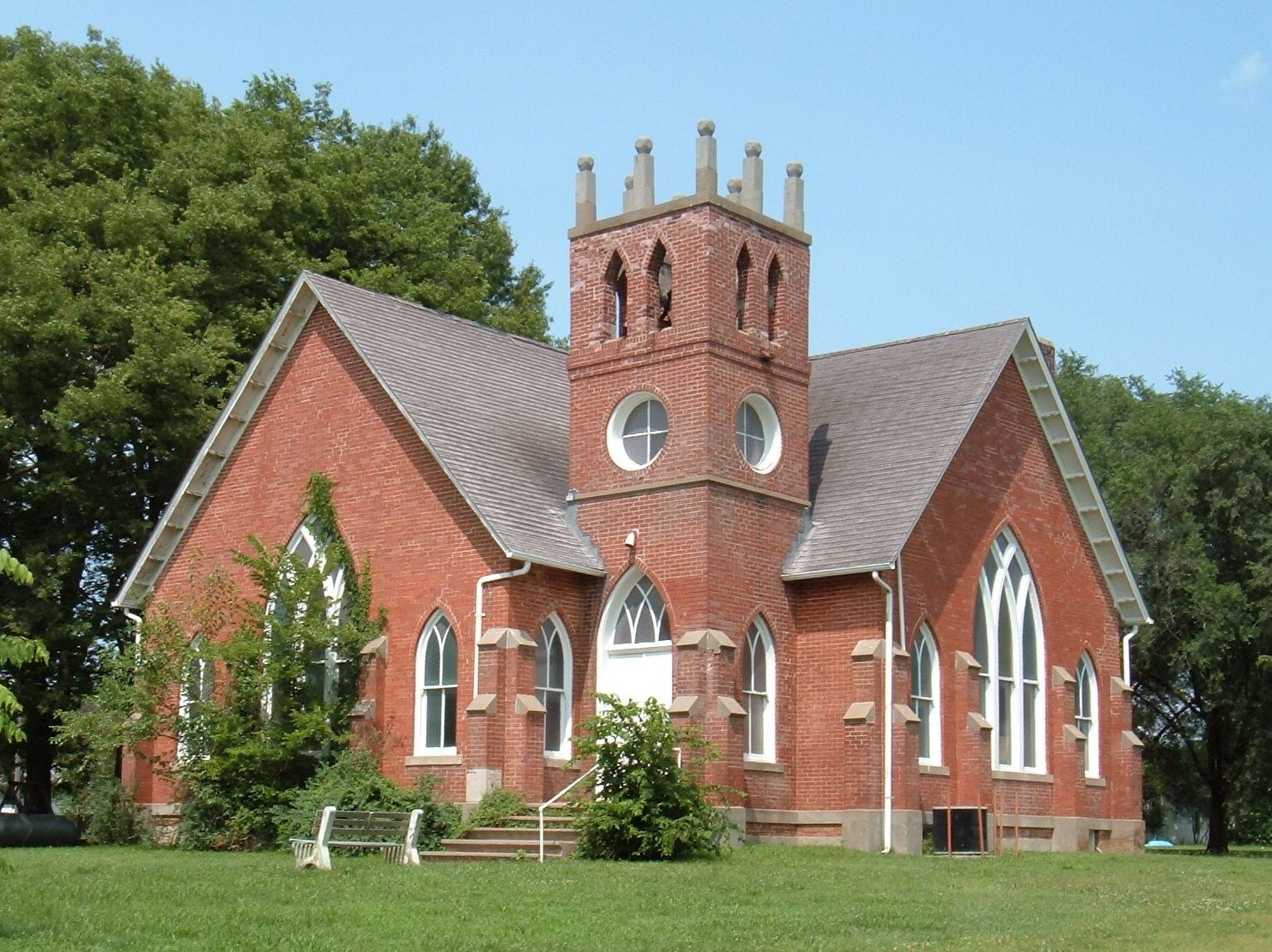 ONE HUNDREDTH ANNIVERSARY
ONE HUNDREDTH ANNIVERSARY
The Weaubleau Christian (Congregational) church celebrated its one hundredth
year, December, 1957. Dr. W. W. Towle, state minister of St. Louis, delivered
the morning message and the dedication service was by Dr. E. Willard Gunckel of
Lebanon, Missouri. Much of the history of the church is in the hands of Eugene
Harryman, church clerk, and a part of it was presented before the public during
the afternoon services. The one hundredth anniversary should be remembered by
all who were concerned--and the church should be thankful to have had such an
event. May God bless those that helped in making it so.
Eugene Harryman
Clerk, 1937-1960
* *
* * * * *
I AM THE WEAUBLEAU
CONGREGATIONAL CHRISTIAN CHURCH
by Berneta Sherman, Reed
Springs, MO
ca. October 1992
I
am the Weaubleau Congregational Christian Church of Weaubleau, Missouri,
sometimes referred to as "The Brick" or "Whitaker Church." I do not object to
any of these titles.
1910 was my birthday, and I was born on the site of the Weaubleau
Christian Institute, as it was being razed, I was being born.
In my early days men of note ministered from my pulpit--namely John
Whitaker, Oliver Whitaker, and Dr. Cooper to name a few.
My doors were open to all. My bell rang loud and clear on Sunday
mornings calling my flock to Sunday school, to church, and Christian Endeavor.
My bell also tolled at the close of funeral services for my members.
At Christmas time my nave was graced by a tall cedar tree laden with
gifts, a Christmas program was always held--giving my children their chance to
be "on stage," and the choir sang beautiful carols. At the close of the program
"Santa" (namely--Charles Brookshire) would appear through a window in the room
off my main chancel to distribute gifts. Once while his granddaughter Kathy, in
her treble voice, was singing "Santa's coming, Santa's coming"--Santa didn't
come. Santa was stuck in the window. Children of my flock remembered these
events long afterwards.
I watched the village of Weaubleau grow and prosper--a village of
churches and God-fearing people; a community interested in educating its young
and providing educational facilities to the best of its abilities.
Many new babies were introduced to religion within my walls and
later professed their faith at my altar and were baptized in my baptistry--better
known as the Weaubleau Creek. Sometimes these believers braved cold winds and
temperatures, even breaking ice to fulfill the symbol of their faith.
Marriages were performed at my altar, starting new lives with my
blessing.
I have also presided over final services for many of my members,
eulogizing those members and reaching out to comfort those I've known and loved
so long.
In many quiet moments of my life I have received and listened as a
silent and thoughtful one coming back home for a visit stepped inside my door,
and for a few peaceful and serene moments offered a prayer or simply stood
remembering other days and other times and other generations--and I then saw
them leave with a lighter step.
As opportunity called so many of my flock to leave and seek wider
fields--my membership and financial support waned. It looked for a time as if my
doors would have to close, but due to the generosity of a member of the Whitaker
family, money was provided for my repair and restoration. Once more a faithful
few sing hymns of praise and thankfulness, and the gospel goes forth from my
pulpit.
I give thanks that I have been an instrument that has helped to
bring hope and promise from the Word of God, touching the lives of many.
In the words of the Poet--"Bless this house Oh Lord I Pray!"
*
* * * * * *
Note: Typed
and posted by Ginny Sharp. Photo of ladies on church steps found in photo album
belonging to Frieda Brookshire Shelton, who is buried in adjacent cemetery.
See also the
MEMBERSHIP REGISTER by following this link.
Return to
PHOTO PAGE or HOME PAGE
 Almost two thousand students had received instruction here. Twenty
three classes with an aggregate of near eighty young men and women graduated
from this school. Weaubleau College had furnished superintendents or principals
for many grade and high schools, besides college and academy instructors, not
only throughout Missouri, but Oklahoma Territory, Arkansas, Nebraska, and Iowa.
Almost two thousand students had received instruction here. Twenty
three classes with an aggregate of near eighty young men and women graduated
from this school. Weaubleau College had furnished superintendents or principals
for many grade and high schools, besides college and academy instructors, not
only throughout Missouri, but Oklahoma Territory, Arkansas, Nebraska, and Iowa.
 In those early years of the Christian Institute, the students set
out beautiful shade trees, and a few of them are still standing today. They have
taken much punishment from ice storms and draughts in recent years, but they
still have much color in the fall of the year. [Photo at
left taken in 1983; tree has since been removed due to disease.]
In those early years of the Christian Institute, the students set
out beautiful shade trees, and a few of them are still standing today. They have
taken much punishment from ice storms and draughts in recent years, but they
still have much color in the fall of the year. [Photo at
left taken in 1983; tree has since been removed due to disease.]
